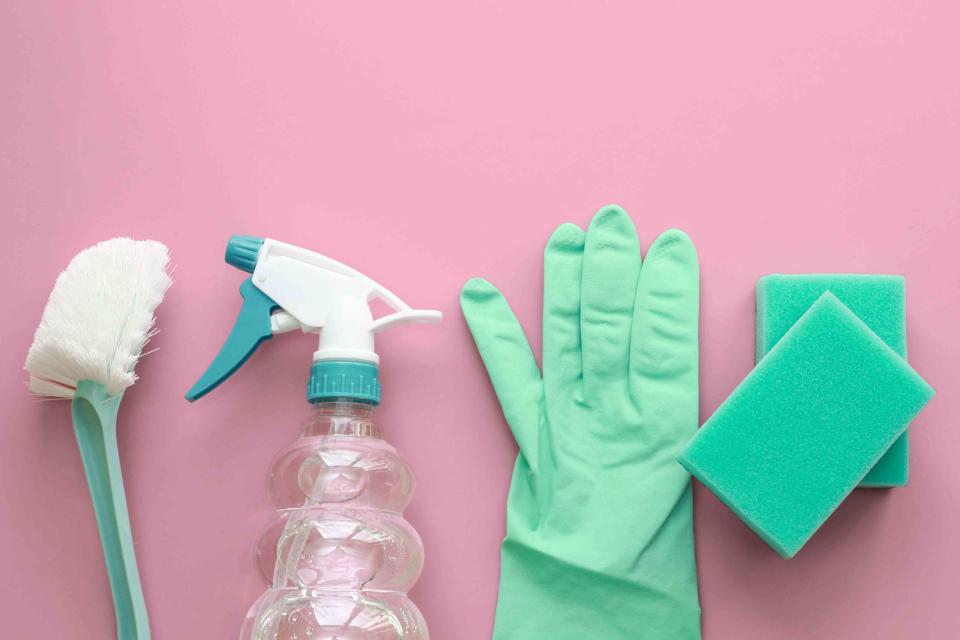10 Bathroom Cleaning Mistakes You Don't Want to Make
Keep things sparkling—and sanitary—by avoiding these errors.

Anna Blazhuk/Getty Images
While it's probably not the highlight of your week, cleaning your bathroom is an essential part of home maintenance and personal hygiene. After all, it's fair to say these are some of the dirtiest spots in most of our homes. So, it's crucial to do things the right way. From cleaning with the wrong supplies to overlooking certain spots, here are ten common bathroom cleaning mistakes.
Related: The Complete Bathroom Cleaning Checklist
Cleaning With Harsh Chemicals
Many think using harsh chemicals is the only way to clean a bathroom. However, this couldn’t be further from the truth according to the founders of L’Avant Collective, Lindsay Droz and Kristi Lord. “Instead of reaching for a cleanser made with bleach, sprinkle a tablespoon or two of baking soda into your sink, tubs, shower drains, or tile, and liberally spray L’AVANT Collective’s Multipurpose Surface Cleaner until it forms a kind of paste with the baking soda. Scrub gently as you normally would, enjoying the aroma of natural scents, and watch as your sinks and drains recover their shine.”
The other problem with using harsh chemicals is that they can create long-term problems not just with your health, but also with your bathroom finishes. “Over-reliance on bleach and other harsh chemicals can degrade materials like grout and sealants over time. Milder, natural solutions like vinegar or baking soda can often do the job just as well without the damage,” explains Robin Murphy of ChirpChirp Cleaning.
Mixing Chemicals
But if you must clean with chemicals, it’s crucial not to mix multiple types according to Dr. Laura Haupert, Ph.D., the Chief Scientific Officer for OMI Industries, which is the parent company of Fresh Wave. “The mixing of harsh chemicals like bleach or ammonia to quickly eliminate odors can produce toxic fumes and irritate the respiratory system, particularly when ventilation is inadequate.”
So, if you plan to clean with more than one type of chemical, be sure to read the warning labels first. You don't want your weekly bathroom cleaning to result in a trip to the hospital.
Scrubbing With Paper Towels
Sure, paper towels make cleaning easier and more convenient, but Spencer Martin, Founder and CEO of Sonic Power tells me they aren't the best choice for your bathroom.
“Paper towels are not ideal because they often leave visible bits and pieces on the mirror. My favorite material is what’s called a Swedish cloth which is made of 100 percent naturally biodegradable cellulose and wood pulp. Furthermore, just one Swedish cloth can replace over a dozen rolls of paper towels.”
Alternatively, you can’t go wrong with a standard microfiber cloth for cleaning just about anything.
Using The Same Cleaning Cloth For All Surfaces
Viviana Holguin of Maid Brigade of Northern Connecticut says using the same cloth or sponge for cleaning the entire bathroom can spread germs from one surface to another. “It’s better to use different clothes for different areas, especially for the toilet.”
So, make sure you have a few fresh cloths on hand at all times.
Using A Dirty Toilet Brush
Let’s be honest, most of us don’t clean out toilet brushes after we use them. This results in the spreading of bacteria and odors. “Toilet brushes should be cleaned and dried after each use and replaced regularly to maintain hygiene,” says Holguin.
Alternatively, a disposable product, such as Clorox ToiletWand is an easier way to get the job done. This eliminates the need to clean and dry a toilet brush while keeping bacteria at bay.
Cleaning The Mirror Improperly
Yes, it matters how you clean your mirror. Martin suggests starting from the top and working your way down. “This way, any drips or clearer residue won't affect areas you’ve already cleaned.”
Avoiding The Drain
One of the stinkiest areas of the bathroom is the drain. Yet, we often neglect to give it the attention it deserves. Haupert tells me, “Not cleaning drains when doing routine bathroom cleaning can result in a buildup of hair, soap scum, and debris, fostering foul odors as bacteria thrive in stagnant water. In addition, not maintaining the proper level of water in P-Traps can result in an unpleasant odor.”
Not Eliminating Mold
Bathrooms have many sources of mold, which isn’t just unsightly and stinky, it can also lead to health issues. In addition to thoroughly cleaning surfaces, Haupert says it’s crucial to wash towels and shower curtains regularly. “Additionally, leaving wet surfaces, such as shower walls and bathtub edges, promotes mold and mildew growth, further exacerbating unpleasant odors.”
Skipping The Germiest Spots
While the big picture is very important when cleaning your bathroom, we can end up skipping a spot or two. So don’t forget to wipe down faucets, the toilet handle, and light switches. This can also help curb the spread of germs and illnesses.
Neglecting The Bathroom Exhaust Fan
The exhaust fan is probably the last thing we have on our minds when cleaning our bathrooms. But Sarah Cook of Nanny’s & Granny’s tells me forgetting to clean this surface can have dangerous consequences. “When not cleaned regularly, these fans can accumulate dust and lint, significantly reducing their efficiency. More critically, a clogged exhaust fan poses a fire hazard, as the build-up can cause the motor to overheat. To prevent such risks and maintain air quality, it’s essential to vacuum the intake surface thoroughly and clean the fan blades every few months.”
For more Real Simple news, make sure to sign up for our newsletter!
Read the original article on Real Simple.

 Yahoo Lifestyle
Yahoo Lifestyle 
